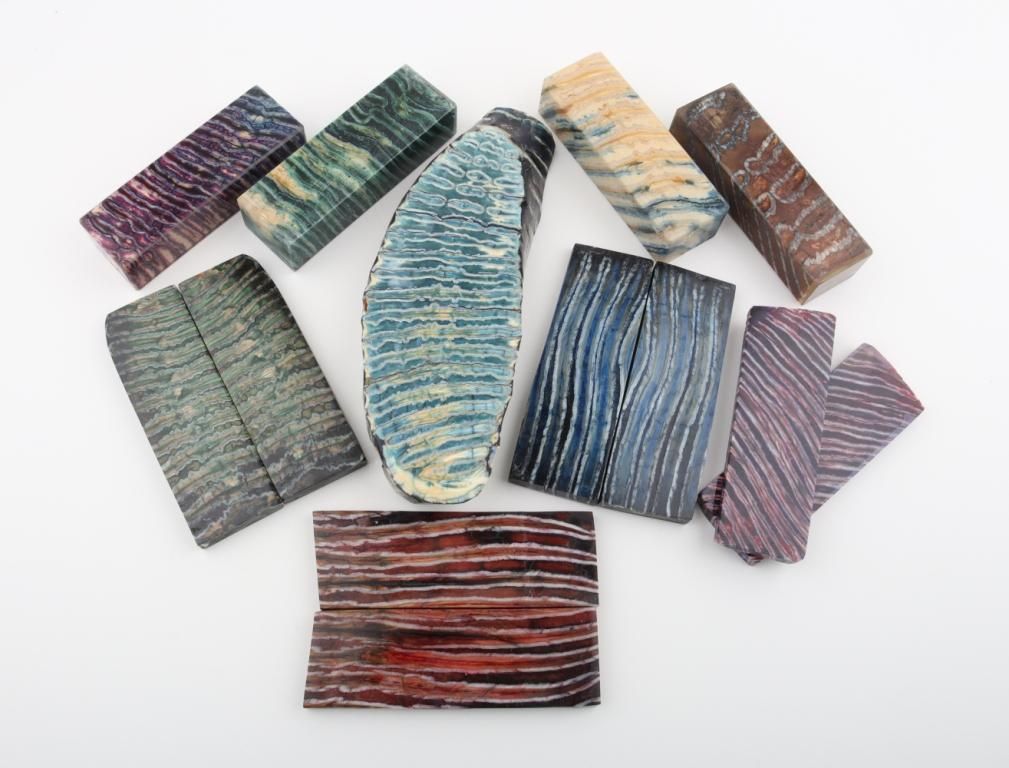
Processing Stabilised Mammoth Molar
Like mammoth ivory, stabilised mammoth molars can be used in various luxury products such as fine handles, bespoke restoration work, inlays, components for musical instruments, jewellery, etc.
General Considerations
First, this article concerns stabilised mammoth molars (or teeth), not mammoth ivory. Natural fossil mammoth molars are much more fragile than natural fossil mammoth ivory (including mammoth bark). Every piece of mammoth molar requires professional stabilisation for artisans to process it. Working with natural mammoth ivory is much easier and less risky than stabilised mammoth molar.
Second, this article only briefly examines some aspects of work with this material. There are a myriad of different tools, skill sets and processing techniques. Additionally, there are tons of different opinions and information available online.
This article highlights the generally essential points, recognising the diversity within this craft.
Structure
A stabilised mammoth molar - be it a whole mammoth tooth or part of a tooth, pre-cut block or knife scales - is a difficult material to process. The natural structure of a mammoth molar consists of three different materials: enamel (outer layer), dentine (core), and cementum (binding matter). Due to the heterogeneous structure, there is always a probability of chipping and cracking when working with it. It is paramount that the mammoth molar has been stabilised professionally to a very high standard.
Drilling
Drilling a stabilised mammoth tooth is challenging but possible. Along the drill’s path, hard enamel and softer bone tissue alternate. This can lead to either the drill sliding to the side or the inability to drill through the enamel itself. It is recommended to use a carbide-tipped drill and drill at high speeds. Drilling at high speeds minimises the risk of the drill being jammed inside the piece.
To minimise chipping when drilling, you need to pay attention to the thickness of the pieces to be drilled.
If you need to drill a piece thinner than 10 mm, you need to reinforce the back of the piece before proceeding. A thin backing plate (g10 spacer, for example) carefully superglued (cyanoacrylates) to the back of the piece will do the job. Before glueing the backing plate, ensure that both surfaces are absolutely clean, straight and even. When finished drilling, you can attach the piece directly without removing the spacer.
The process is a bit simpler if you need to drill a piece thicker than 10 mm. Carefully measure and mark all sides, projecting the exact directions of the holes to be drilled. Drill a bit deeper than the middle from each side. The aim is for the holes to align and meet inside the piece because this will avoid chipping.
Sanding and Grinding
It is recommended to use a good-quality belt grinder or a belt sander. To avoid the appearance of “waves” on the finished product, it is recommended to grind stabilised mammoth molar using a rigid substrate under the sandpaper.
In the first step, you can start with a 40-grit sandpaper. This is a rough removal, needed only to remove the main mass. When you gradually approach the final shape, you can switch to a 60-grit or 80-grit sandpaper. The finer the abrasive grain, the less likely it is to tear a piece from the stabilised mammoth molar. The belt speed can be reduced at this stage as the abrasive decreases. Monitor the heat of the material and keep an eye out for the wear of the belt.
With each processing step, small cracks or fissures might appear. The best fix for this is using a quality superglue (cyanoacrylates). Carefully fill all cracks, cavities and fissures. Add super glue until it is even with the surface. Patience and careful tinkering are required at this stage. You can use a file, preferably with small notches, to even out the surface.
If you have any further questions or require further explanations, please email us: info@arcticantiques.com